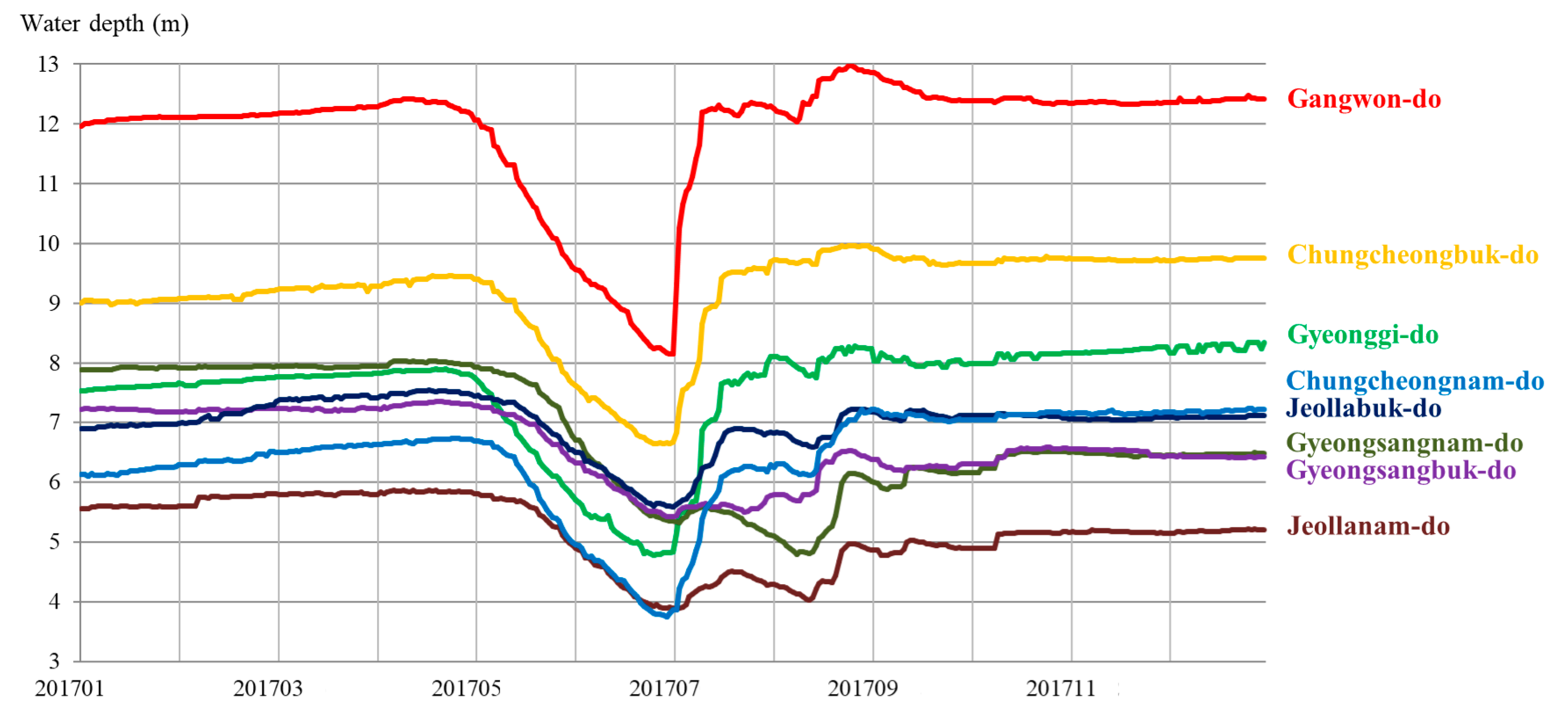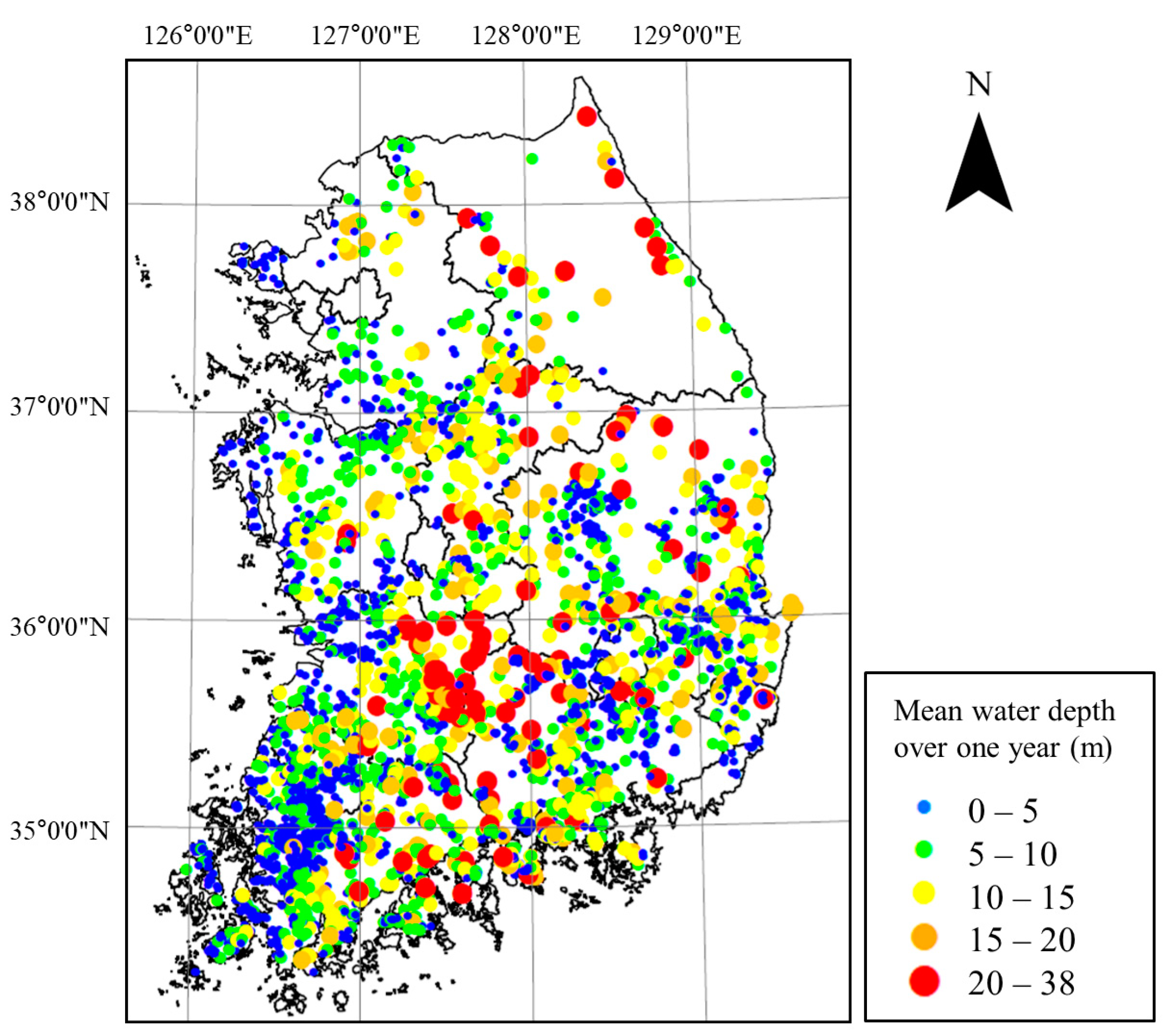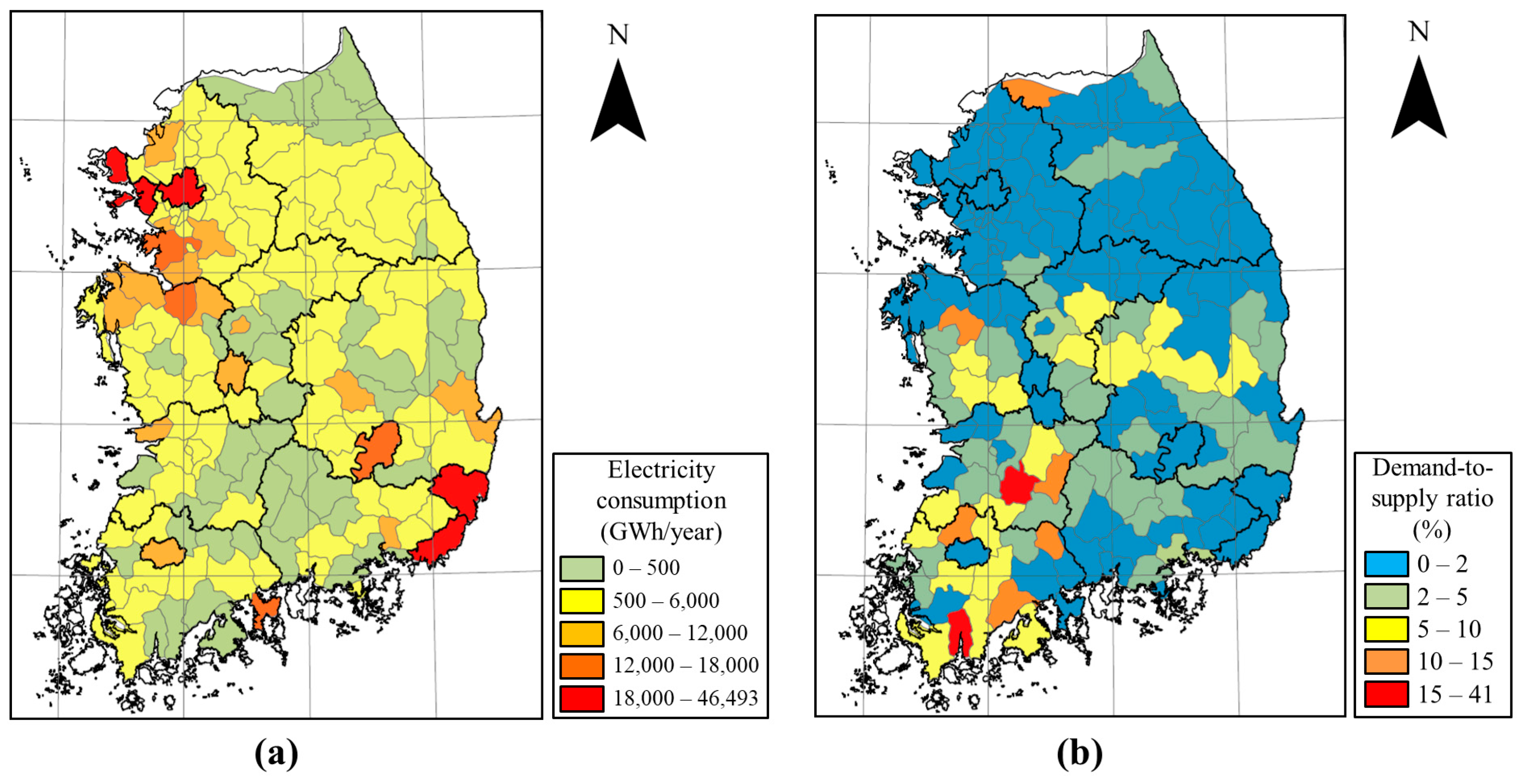Analysis and Prioritization of the Floating Photovoltaic System Potential for Reservoirs in Korea
Abstract
:1. Introduction
2. Study Area and Data
3. Methods
3.1. Point Irradiance Calculation and Interpolation
3.2. Solar Irradiance Map based on Shadow Analysis
3.3. Constraint Analysis on Reservoir Depth
3.4. Design and Evaluation of the PV System
3.5. Economic Assessment and GHG Reduction
4. Results
5. Conclusions
Author Contributions
Funding
Acknowledgments
Conflicts of Interest
References
- The International Renewable Energy Agency (IRENA). Renewable Capacity Statistics 2018; IRENA: Abu Dhabi, United Arab Emirates, 2018. [Google Scholar]
- Choi, Y.K. A Study on Power Generation Analysis of Floating PV System Considering Environmental Impact. Int. J. Softw. Eng. Appl. 2014, 8, 75–84. [Google Scholar] [CrossRef]
- Sahu, A.; Yadav, N.; Sudhakar, K. Floating photovoltaic power plant: A review. Renew. Sust. Energ. Rev. 2016, 66, 815–824. [Google Scholar] [CrossRef]
- Galdino, M.; de Almeida Olivieri, M.M. Some Remarks about the Deployment of Floating PV Systems in Brazil. J. Elec. Eng. 2017, 5, 10–19. [Google Scholar] [CrossRef]
- The World Bank. Where Sun Meets Water: Floating Solar Market Report; The World Bank: Washington, DC, USA, 2018. [Google Scholar]
- Minamino, S. Floating Solar Plnats: Niche Rising to the Surface? Available online: https://www.solarplaza.com/channels/top-10s/11634/floating-solar-plants-niche-rising-surface/ (accessed on 28 December 2018).
- Osborne, M. China Completes Largest Floating Solar Power Plant. Available online: https://www.pv-tech.org/news/china-completes-largest-floating-solar-power-plant (accessed on 28 December 2018).
- Lee, Y.G.; Joo, H.J.; Yoon, S.J. Design and installation of floating type photovoltaic energy generation system using FRP members. Sol. Energy 2014, 108, 13–27. [Google Scholar] [CrossRef]
- Kim, S.H.; Yoon, S.J.; Choi, W. Design and Construction of 1 MW Class Floating PV Generation Structural System Using FRP Members. Energies 2017, 10, 1142. [Google Scholar] [CrossRef]
- Choi, Y.K.; Kim, I.S.; Hong, S.T.; Lee, H.H. A Study on Development of Azimuth Angle Tracking Algorithm for Tracking-type Floating Photovoltaic System. Adv. Sci. Technol. Lett. 2014, 51, 197–202. [Google Scholar] [CrossRef]
- Choi, Y.K.; Lee, N.H.; Lee, A.K.; Kim, K.J. A Study on Major Design Elements of Tracking-Type Floating Photovoltaic Systems. Int. J. Smart Grid Clean Energy 2014, 3, 70–74. [Google Scholar] [CrossRef]
- Lee, A.K.; Shin, G.W.; Hong, S.T.; Choi, Y.K. A Study on Development of ICT Convergence Technology for Tracking-Type Floating Photovoltaic Systems. Int. J. Smart Grid Clean Energy 2014, 3, 80–87. [Google Scholar] [CrossRef]
- Song, J.; Choi, Y.; Yoon, S.H. Analysis of Photovoltaic Potential at Abandoned Mine Promotion Districts in Korea. Geosyst. Eng. 2015, 18, 168–172. [Google Scholar] [CrossRef]
- Song, J.; Choi, Y. Analysis of the Potential for Use of Floating Photovoltaic Systems on Mine Pit Lakes: Case Study at the Ssangyong Open-Pit Limestone Mine in Korea. Energies 2016, 9, 102. [Google Scholar] [CrossRef]
- Lee, K.R.; Lee, W.H. Floating Photovoltaic Plant Location Analysis using GIS. J. Korean Soc. Geospat. Inf. Syst. 2016, 24, 51–59. [Google Scholar] [CrossRef]
- Lee, S.H.; Lee, N.H.; Choi, H.C.; Kim, J.O. Study on Analysis of Suitable Site for Development of Floating Photovoltaic System. J. Korean Inst. Illum. Electr. Install. Eng. 2012, 26, 30–38. [Google Scholar]
- Oh, M.; Park, H.D. A new algorithm using a pyramid dataset for calculating shadowing in solar potential mapping. Renew. Energy 2018, 126, 465–474. [Google Scholar] [CrossRef]
- Perez, R.; Seals, R.; Michalsky, J. All-Weather Model for Sky Luminance Distribution—Preliminary Configuration and Validation. Sol. Energy 1993, 50, 235–245. [Google Scholar] [CrossRef]
- NREL. STAT FAQs Part 1: Floating Solar. Available online: https://www.nrel.gov/state-local-tribal/blog/posts/stat-faqs-part1-floating-solar.html (accessed on 28 December 2018).
- Patil, S.S.; Wagh, M.M.; Shinde, N.N. A Review on Floating Solar Photovoltaic Power Plants. Int. J. Sci. Eng. Res. 2017, 8, 789–794. [Google Scholar]
- Palmer, D.; Cole, I.; Betts, T.; Gottschalg, R. Interpolating and Estimating Horizontal Diffuse Solar Irradiation to Provide UK-Wide Coverage: Selection of the Best Performing Models. Energies 2017, 10, 181. [Google Scholar] [CrossRef]
- Kang, Y.H. KOREA Renewable Energy Resource Atlas; Korea Institute of Energy Research: Daejeon, Korea, 2015. [Google Scholar]
- Evrendilek, F.; Ertekin, C. Assessing solar radiation models using multiple variables over Turkey. Clim. Dynam. 2008, 31, 131–149. [Google Scholar] [CrossRef]
- LSIS. Floating Photovoltaic System; LS Industrial Systems: Anyang, Korea, 2016. [Google Scholar]
- Kim, G.H. Water Solar Power Plant That Sits Down on the Ground Due to Drought. Available online: https://www.yna.co.kr/view/AKR20170626109700061 (accessed on 28 December 2018).
- RETScreen International Clean Energy Decision Support Centre. Clean Energy Project Analysis, RETScreen Engineering & Cases Textbook; CANMET Energy Technology Centre: Montreal, QC, Canada, 2005. [Google Scholar]
- Battaglia, C.; Cuevas, A.; De Wolf, S. High-efficiency crystalline silicon solar cells: Status and perspectives. Energy Environ. Sci. 2016, 9, 1552–1576. [Google Scholar] [CrossRef]
- Yoshikawa, K.; Kawasaki, H.; Yoshida, W.; Irie, T.; Konishi, K.; Nakano, K.; Uto, T.; Adachi, D.; Kanematsu, M.; Uzu, H.; et al. Silicon heterojunction solar cell with interdigitated back contacts for a photoconversion efficiency over 26%. Nat. Energy 2017, 2, 17032. [Google Scholar] [CrossRef]
- Lee, C.Y. Equalization Cost through Solar Cost Analysis International Comparative Analysis; Korea Energy Economics Institute: Ulsan, Korea, 2017. [Google Scholar]
- MOTIE. Guidelines for Management and Operation of New and Renewable Energy Supply Mandatory System and Fuel Mixture Mandatory System; Ministry of Trade, Industry and Energy: Sejong, Korea, 2018.
- Europe’s Largest Floating Solar Farm to Open. Available online: https://www.bbc.com/news/uk-england-london-35705345 (accessed on 28 December 2018).










| Type | Parameter | Value |
|---|---|---|
| Solar cell module | Model | SPR-210-BLK |
| Length (m) | 1.56 | |
| Width (m) | 0.80 | |
| Power capacity (kW/unit) | 0.21 | |
| Efficiency (%) | 16.9 | |
| Nominal Operating cell temperature (°C) | 46 | |
| Temperature coefficient (%/°C) | −0.4 | |
| Losses (%) | 1 | |
| Inverter | Model | SPR-12000f |
| Efficiency (%) | 95.5 | |
| Capacity (kW/unit) | 12.5 | |
| Losses (%) | 0 |
| Installation area to reservoir area ratio (%) | 10 | 20 | 30 | 40 | 50 | 60 | 70 | 80 | 90 | 100 |
| Number of reservoirs satisfying 100 kW | 1134 | 1201 | 1218 | 1225 | 1230 | 1234 | 1236 | 1236 | 1236 | 1236 |
| Maximum capacity (MW) | 75.85 | 151.70 | 227.55 | 303.40 | 379.25 | 455.10 | 530.95 | 606.80 | 682.65 | 758.50 |
| Total capacity (MW) | 2102.89 | 4216.33 | 6326.63 | 8436.33 | 10,545.97 | 12,655.63 | 14,765.12 | 16,874.42 | 18,983.73 | 21,093.03 |
| Total power production (GWh/year) | 2931.94 | 5878.65 | 8820.95 | 11,762.40 | 14,703.79 | 17,645.20 | 20,586.38 | 23,527.30 | 26,468.21 | 29,409.12 |
| Number of Reservoirs | Mean Water Depth (m) | Mean Reservoir Area (km2) | Mean Irradiance (kW/m2/day) | Mean PV Capacity (MW) | Maximum PV Capacity (MW) | Total PV Capacity (MW) | Mean Power Production (GWh/year) | Maximum Power Production (GWh/year) | Total Power Production (GWh/year) | Total GHG Reduction (1000 tCO2/year) | |
|---|---|---|---|---|---|---|---|---|---|---|---|
| Gangwon-do | 48 | 12.09 | 0.50 | 3714.40 | 2.43 | 30.28 | 116.81 | 3.28 | 41.21 | 157.36 | 69.47 |
| Gyeonggi-do | 50 | 9.78 | 0.64 | 3704.45 | 3.61 | 24.60 | 180.60 | 4.88 | 34.20 | 244.19 | 107.81 |
| Gyeongsangnam-do | 167 | 12.23 | 0.22 | 3864.00 | 0.81 | 6.22 | 135.27 | 1.11 | 8.73 | 184.85 | 81.61 |
| Gyeongsangbuk-do | 227 | 11.26 | 0.38 | 3814.96 | 1.75 | 20.48 | 397.25 | 2.45 | 29.07 | 556.32 | 245.62 |
| Jeollanam-do | 285 | 9.96 | 0.32 | 3987.81 | 1.50 | 54.94 | 427.50 | 2.17 | 80.51 | 617.29 | 272.53 |
| Jeollabuk-do | 149 | 12.37 | 0.38 | 3798.40 | 1.95 | 75.25 | 290.11 | 2.67 | 102.39 | 397.32 | 175.42 |
| Chungcheongnam-do | 98 | 9.78 | 0.61 | 3877.83 | 3.65 | 75.85 | 357.75 | 5.16 | 107.58 | 505.29 | 223.09 |
| Chungcheongbuk-do | 110 | 12.43 | 0.40 | 3781.62 | 1.79 | 26.56 | 197.18 | 2.45 | 36.71 | 269.32 | 118.90 |
| Sum | 1134 | 2068.53 | 2931.94 | 1294.45 |
| Rank | Reservoir Name | Province | City | Reservoir Area (km2) | Capacity (MW) | Power Production (GWh/year) | GHG Reduction (ton) | NPV (10,000 USD) | Pay Back (year) | |
|---|---|---|---|---|---|---|---|---|---|---|
| Floating PV installed in proportion to the area of the reservoir (High power production) | 1 | Yedang | Chungcheongnam-do | Yesan | 8.83 | 75.85 | 107.58 | 47,494.86 | 17,513.99 | 4.42 |
| 2 | Seomjin | Jeollabuk-do | Imsil | 10.11 | 75.25 | 102.39 | 45,205.39 | 16,191.54 | 4.70 | |
| 3 | Najuho | Jeollanam-do | Naju | 7.19 | 54.94 | 80.51 | 35,544.71 | 13,392.70 | 4.21 | |
| 4 | Topjeong | Chungcheongnam-do | Nonsan | 5.82 | 47.20 | 67.77 | 29,921.57 | 11,125.65 | 4.34 | |
| 5 | Togyo | Gangwon-do | Cheorwon | 3.92 | 30.28 | 41.21 | 18,195.17 | 6518.30 | 4.69 | |
| 6 | Miho | Chungcheongbuk-do | Jincheon | 4.42 | 26.56 | 36.71 | 16,206.52 | 5869.99 | 4.59 | |
| 7 | Gosam | Gyeonggi-do | Anseong | 3.56 | 24.60 | 34.20 | 15,101.31 | 5493.85 | 4.55 | |
| 8 | Bulgop | Jeollanam-do | Yeonggwang | 3.20 | 21.44 | 31.70 | 13,996.68 | 5304.63 | 4.15 | |
| 9 | Yidong | Gyeonggi-do | Yongin | 2.87 | 22.00 | 30.31 | 13,382.42 | 4836.23 | 4.61 | |
| 10 | Deokdong | Gyeongsangbuk-do | Gyeongju | 3.11 | 20.48 | 29.08 | 12,836.71 | 4736.96 | 4.41 | |
| Floating PV with 100 kW capacity (High efficiency) | 1 | Naesan | Jeollanam-do | Haenam | 0.11 | 0.10 | 0.16 | 69.08 | 27.08 | 3.82 |
| 2 | Jangsan | Jeollanam-do | Shinan | 0.14 | 0.10 | 0.16 | 69.04 | 27.06 | 3.82 | |
| 3 | Gopyeong | Jeollanam-do | Haenam | 0.08 | 0.10 | 0.16 | 68.86 | 26.95 | 3.84 | |
| 4 | Cheongsu | Jeollanam-do | Muan | 0.15 | 0.10 | 0.16 | 68.54 | 26.75 | 3.86 | |
| 5 | Illo | Jeollanam-do | Muan | 0.75 | 0.10 | 0.15 | 68.39 | 26.66 | 3.88 | |
| 6 | Gwangdae | Jeollanam-do | Shinan | 0.41 | 0.10 | 0.15 | 68.21 | 26.55 | 3.89 | |
| 7 | Sindeok | Jeollanam-do | Yeongam | 0.13 | 0.10 | 0.15 | 68.20 | 26.54 | 3.89 | |
| 8 | Dopyeong | Jeollanam-do | Jindo | 0.11 | 0.10 | 0.15 | 68.09 | 26.48 | 3.90 | |
| 9 | Sungdong | Jeollanam-do | Muan | 0.17 | 0.10 | 0.15 | 68.02 | 26.43 | 3.91 | |
| 10 | Sungyang | Jeollanam-do | Yeongam | 0.40 | 0.10 | 0.15 | 67.77 | 26.28 | 3.93 |
© 2019 by the authors. Licensee MDPI, Basel, Switzerland. This article is an open access article distributed under the terms and conditions of the Creative Commons Attribution (CC BY) license (http://creativecommons.org/licenses/by/4.0/).
Share and Cite
Kim, S.-M.; Oh, M.; Park, H.-D. Analysis and Prioritization of the Floating Photovoltaic System Potential for Reservoirs in Korea. Appl. Sci. 2019, 9, 395. https://doi.org/10.3390/app9030395
Kim S-M, Oh M, Park H-D. Analysis and Prioritization of the Floating Photovoltaic System Potential for Reservoirs in Korea. Applied Sciences. 2019; 9(3):395. https://doi.org/10.3390/app9030395
Chicago/Turabian StyleKim, Sung-Min, Myeongchan Oh, and Hyeong-Dong Park. 2019. "Analysis and Prioritization of the Floating Photovoltaic System Potential for Reservoirs in Korea" Applied Sciences 9, no. 3: 395. https://doi.org/10.3390/app9030395





